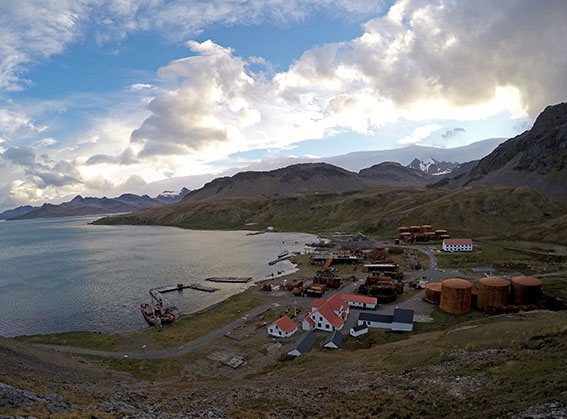
With some reluctance we had to spend 4 days in Grytviken harbour during our first week of fieldwork due to bad weather, as the worst storm of the season swept across South Georgia. We saw up to 55 knots on the wind instrument but it would have been much stronger out at sea.
While waiting for better conditions the crew tackled various boat jobs and the scientists double checked their equipment and fine-tuned their data gathering methods for working on the foredeck. Amy gave a demonstration on how to care for and clean the cameras after use in the salty marine environment, plus a useful lesson in photo identification techniques.
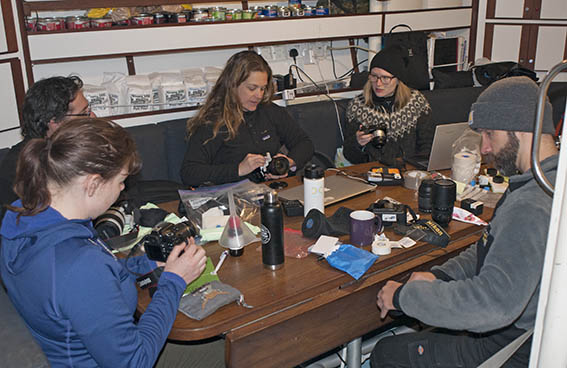
Being on the dock allowed everyone to come and go as they pleased and there was much exploring to be done. One of South Georgia’s many highlights is the wildlife and even without leaving the boat we could see and hear numerous fur seals, elephant seals and king penguins. The seals wiffle and wail and grunt, while the penguins make a musical trumpeting call. The fur seal pups are at a delightful age, small, playful and inquisitive. Walking ashore involves navigating a route between seals, both adults and pups, many of which make mock aggressive charges with teeth bared. Carrying a blodger (a stick of any shape or form) is a smart idea as pointing it at an advancing seal acts as an effective deterrent.
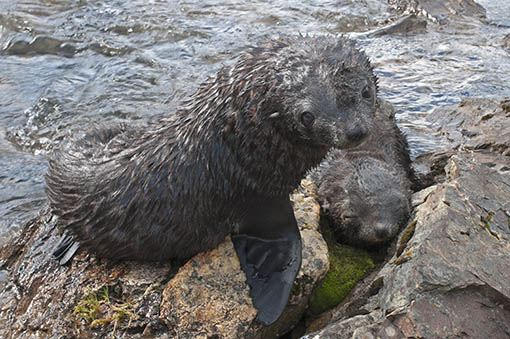
Early on Saturday morning we left the dock and headed out. The forecast was less than 25 knots for the first time since we arrived and although we knew conditions might not be ideal, we had to try to find some whales. The plan was to spend the morning searching the two long fjords of Cumberland Bay. A Southern right had been seen in the eastern arm the previous evening at last light. Grytviken remained shrouded in rain but in the fjord we were in sunshine with a brilliant rainbow behind us. Ice chunks calved from the glaciers at the head of the bay drifted past and the scenery was spectacular.
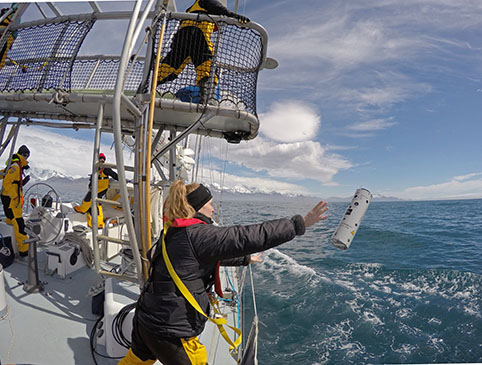
By the time we entered the western arm, the wind was howling down from the glacier, gusting to over 40 knots and whipping the sea into a frenzy. Observers could hardly see anything in stinging rain and spray so we turned out to sea, where Susie and Russell could deploy a sonobuoy. They soon picked up vocalisations that were most likely Southern rights somewhere to the north, possibly in the area where we found whales on the way in. But the sea was too rough for us to investigate further. Instead we stayed close to shore, hoping for a bit of shelter, only to find the wind funnelling out of every bay. By early afternoon we had to admit that conditions were impossible to work in.
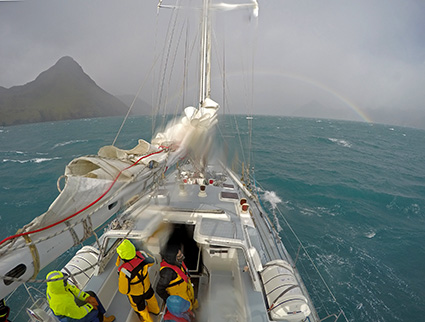
Our two means of locating whales are by visual observations and/or by detecting them acoustically. The sonobuoys provide a compass bearing to any vocalisations detected and if two sonobuoys are used it is possible to obtain a fairly accurate position where the two bearings cross. One of the challenges particular to this project is that Southern right whales appear to vocalise infrequently, making them harder to detect acoustically than some other whale species. Antarctic blues, for example, make fairly constant, repeated vocalisations which Susie and Russell have detected almost every time they deploy a sonobuoy. In contrast, the Southern rights make very brief vocalisations, followed by prolonged silences.
Whales can be spotted at the surface when they blow or reveal their heads, backs or tail flukes. In good visibility the blows of many whale species, including Southern rights, can be seen at some distance. But as the wind increases beyond about 15 knots the sea becomes more turbulent and covered in white caps, making it much harder to locate whales at the surface. In addition, the project goals of tagging and obtaining DNA samples become ever more difficult in rough conditions. Calm weather is rare in South Georgia, which may be one reason this research has not been attempted before.
After a night in a relatively sheltered anchorage at Ocean Harbour we set off again at 6 a.m., undeterred, to take advantage of a possible short weather gap, forecast to be less than 15 knots until lunchtime. By 8 a.m. we had 30 – 35 knots, rough seas and no whales. We returned to Ocean Harbour for a late breakfast and spent the rest of the day undertaking minor repairs and equipment maintenance. Some of the team enjoyed a hike ashore amidst penguins and seals, while others caught up on some sleep.
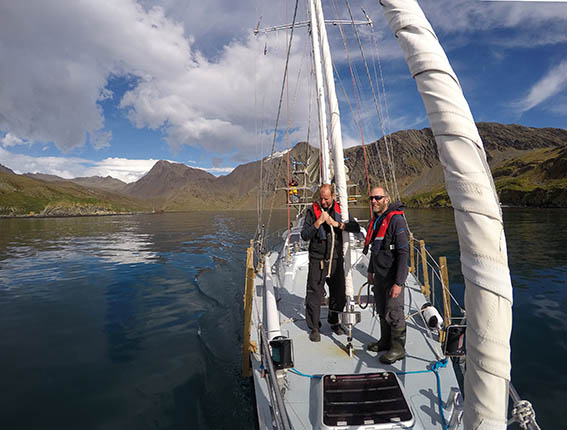
With another promising forecast, we were up at at 4 a.m. the next day and were motoring out of the anchorage as the sun rose half an hour later. Spirits were high as the surroundings were magical and the sea was quiet. We spent the first few hours moving slowly northeast, following elusive whales that blew in the distance then disappeared on dives of up to 20 minutes. Amy managed to capture some photo ID images but we couldn’t approach the whales closely enough to take any samples.
Then Susie and Russell picked up some probable Southern right vocalisations to the southeast, near Royal Bay where we’d had reports of whale sightings. Although they heard just 5 faint vocalisations, the bearing from the sonobuoy allowed them to determine where to head for. In under an hour, blows were seen quite close inshore and we were soon approaching two Southern right whales that appeared to be socialising at the surface.
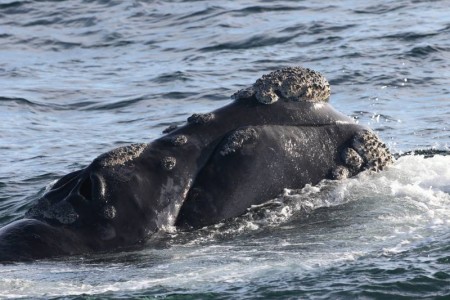
Finding whales was just the first stage. For the next few hours we remained in the area, seeing numerous blows but ultimately photographing just 3 new animals. There was a moderate swell but Matt and Emma felt there was a good chance of obtaining some biopsies. Ideally they need to be within 30m of a whale, at the right angle and with a clear view of its back. At the optimum moment a fog bank rolled in and we almost lost the whales as visibility was reduced to less than 500m. But eventually all the elements came together and to great excitement, skin samples from 2 whales were taken.
It was just in time in the ever-unpredictable South Georgia weather. What we had thought was a light mist turned out to be a wall of spray advancing across the water and suddenly the wind increased to gale force. We later heard from a cruise ship that they experienced 70 knot gusts not far from where we were working. We turned northwest and ran up the coast to find shelter in the anchorage of Godthul.
Kirstin.
Sorry, comments are closed for this post.